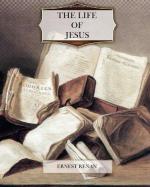[Footnote 2: Luke l.c.; John xxi. 13.]
[Footnote 3: Comp. Matt. vii. 10, xiv. 17, and following, xv. 34, and following; Mark vi. 38, and following; Luke ix. 13, and following, xi. 11, xxiv. 42; John vi. 9, and following, xxi. 9, and following. The district round Lake Tiberias is the only place in Palestine where fish forms a considerable portion of the diet.]
[Footnote 4: John xxi. 13; Luke xxiv. 42, 43. Compare the oldest representations of the Lord’s Supper, related or corrected by M. de Rossi, in his dissertation on the [Greek: ICHTHYS] (Spicilegium Solesmense de dom Pitra, v. iii., p. 568, and following). The meaning of the anagram which the word [Greek: ICHTHYS] contains, was probably combined with a more ancient tradition on the place of fish in the Gospel repasts.]
Their repasts were among the sweetest moments of the infant community. At these times they all assembled; the master spoke to each one, and kept up a charming and lively conversation. Jesus loved these seasons, and was pleased to see his spiritual family thus grouped around him.[1] The participation of the same bread was considered as a kind of communion, a reciprocal bond. The master used, in this respect, extremely strong terms, which were afterward taken in a very literal sense. Jesus was, at the same time, very idealistic in his conceptions, and very materialistic in his expression of them. Wishing to express the thought that the believer only lives by him, that altogether (body, blood, and soul) he was the life of the truly faithful, he said to his disciples, “I am your nourishment”—a phrase which, turned in figurative style, became, “My flesh is your bread, my blood your drink.” Added to this, the modes of speech employed by Jesus, always strongly subjective, carried him still further. At table, pointing to the food, he said, “I am here”—holding the bread—“this is my body;” and of the wine, “This is my blood”—all modes of speech which were equivalent to, “I am your nourishment.”
[Footnote 1: Luke xxii. 15.]
This mysterious rite obtained great importance in the lifetime of Jesus. It was probably established some time before the last journey to Jerusalem, and it was the result of a general doctrine much more than a determinate act. After the death of Jesus, it became the great symbol of Christian communion,[1] and it is to the most solemn moment of the life of the Saviour that its establishment is referred. It was wished to see, in the consecration of bread and wine, a farewell memorial which Jesus, at the moment of quitting life, had left to his disciples.[2] They recognized Jesus himself in this sacrament. The wholly spiritual idea of the presence of souls, which was one of the most familiar to the Master, which made him say, for instance, that he was personally with his disciples[3] when they were assembled in his name, rendered this easily admissible. Jesus, we have already said, never had a very defined notion




